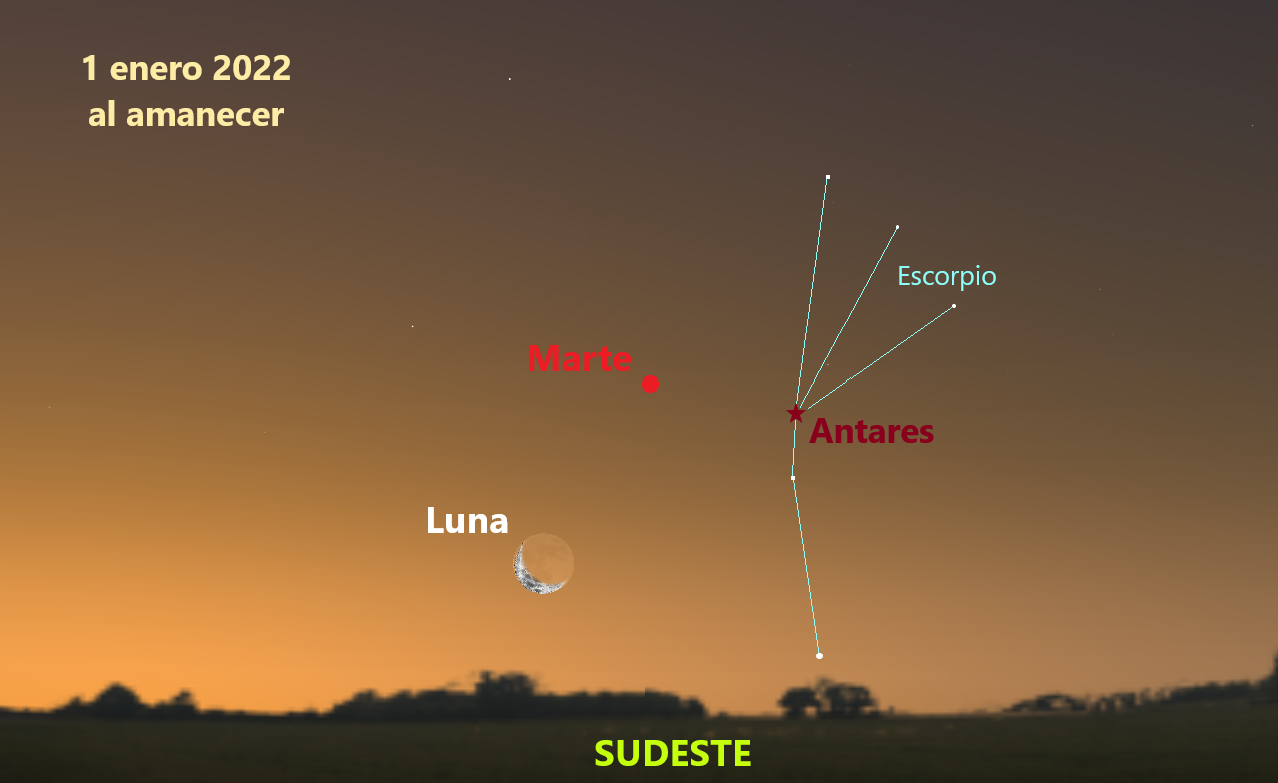Seasons Ten curiosities about winter: solstice and the heavens
The sunset of January 1 offers us a beautiful conjunction of 4 planets: Venus, Mercury, Saturn and Jupiter are shown aligned along the ecliptic on the southwest horizon.
At dawn it will be possible to observe Mars with its rival, the star Antares, and the fine edge of the waning moon.
Four in line
Venus says goodbye to the evening skies, where it has shone brilliantly for the past few weeks.
On January 1, at around 6:30 p.m. (peninsular time), it will still be possible to observe it along with three of its sister planets.
Mercury will be visible slightly higher than Venus, about four degrees to your left.
Being so extremely low, observing these small planets will require a truly transparent sky and a horizon clear of obstacles.
Good binoculars would also be of great help in locating them.
It is less difficult to observe Saturn and Jupiter, which at this time are relatively high above the horizon.
The imaginary line that joins the positions of the four planets is the so-called 'ecliptic', on this same line.
that crosses the constellations of the zodiac traced by ancient civilizations, the major objects of the solar system are located.
The name of this line, ecliptic, refers to the fact that eclipses always occur on it.
Venus, Mercury and Saturn will barely be visible for an hour after twilight, they will soon hide, followed by Jupiter, which will also lose height as night begins.
Although these four planets appear so close in the sky, let us remember that they are at very different distances from Earth.
The distance to Venus is now only 25 million miles (27% of the Earth-Sun distance), which is why it appears so extremely bright.
Mercury is 171 million kilometers, this is 4 times farther than Venus.
The distances to Jupiter and Saturn are 834 and 1612 million kilometers, respectively;
that is, Saturn is twice as far away as Jupiter and 40 times as far as Venus.
Their different distances, sizes and atmospheric compositions make the four planets show very different brightness.
Venus is now 25 times brighter than Mercury, 7 times brighter than Jupiter, and 100 times brighter than Saturn.
Ares and Antares
The morning star in these first days of the year is still Mars, which, compared to the splendid evening stars, shines very modestly.
It is 5 times dimmer than Saturn and almost 500 times dimmer than Venus.
At dawn on January 1 we can see it together with the very fine edge of the waning moon (the new moon will take place on the 2nd).
Also very close can be seen the star Antares, the brightest in the constellation Scorpio, a red supergiant of variable luminosity that is 550 light years away.
The name Antares, of Greek origin, means 'the rival of Ares'.
This name is due to the fact that the reddish glow of Antares rivals that of Mars (Ares in Greek).
The contrast between the two stars has been made in different cultures because both coincide in a very close region of the sky with a period of one year and eleven months.
This periodic coincidence is determined by the situation of Antares, very close to the ecliptic, and the period of translation of Mars around the Sun.
January 1, Mars, Moon, and Antares shortly before sunrise Stellarium / RB
Now, the red planet is still very far from Earth, about 350 million kilometers (2.3 times farther than the Sun).
But, as the weeks go by, it will continue to approach us and, as it passes through all the constellations of the Zodiac, it will form beautiful conjunctions with the other planets throughout the year 2022. The optimal moment for its observation will take place on December 8 when it will be in opposition to the Sun, fully illuminated.
Happy new orbit
What better way to start the year than by looking up at the sublime skies.
The tranquility of the calm winter nights, if the atmosphere allows it, offers us optimal moments to consider good intentions and reflect on the future.
The planets, before the immense ocean of stars, make us aware of our journey through space.
Another orbit completed.
Happy New Year.
According to the criteria of The Trust Project
Know more
Science and Health
science
EnvironmentThe 'thermopoly' of the 21st century: how to cook 120 servings of lentils in an hour without fossil fuels
ScienceA family from 5,700 years ago: oldest family tree reveals adoptions, stepchildren and polygamy
ScienceA second cone grows "at high speed" on La Palma
See links of interest
Last News
What
2022 business calendar
Check Christmas Lottery
Covid passport
Loteria del Niño 2022
Check Child's Lottery
How to make seafood
Valencia CF - Espanyol
Arsenal - Manchester City

